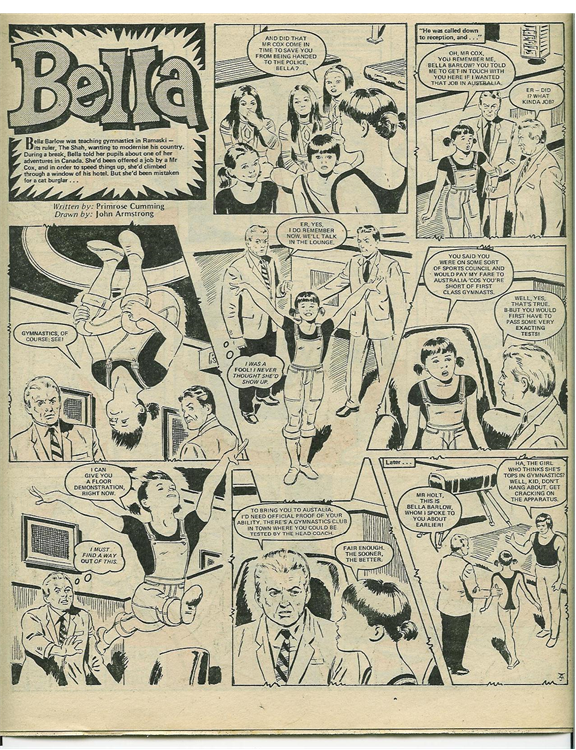Comics, Childhood and Memory—An Autobiography (Part 3 of 3) by Melanie Gibson
/Comics, Childhood and Memory: An Autobiography (Part 3 of 3)
Melanie Gibson
A very contrasting example, which moves away from the concept of agency and glamour and reflects the move towards learning through difficulty and emotional turmoil, is seen in Figure 9, a story which featured in Tammy from 1974 to 1984.
As noted above stories in British girls’ comics generally became bleaker as the twentieth century progressed, and made extensive use of the victim heroine motif. Here, as well as incorporating the increasingly fashionable activity of gymnastics, popularized through television coverage of the Olympic Games in the 1970s, especially through the figure of Olga Korbut, the story features a main character who is another working class outsider. As with the school stories mentioned earlier, the focus is on Bella’s trials and challenges, initially at the hands of relatives who want her to use her skills to steal on their behalf, and later on the part of the gymnastic establishment, as the example below shows. However, in contrast to the adult male characters her body constantly breaks the frame and the images seem to celebrate the inability of the form of the comic to control her moving figure. The narrative also celebrates her class position, rather than attempting to direct her into becoming a middle-class girl, and locates her as thriving, rather than simply surviving.
Bella at the Bar’ (Tammy, IPC, Jan. 15 1983, pp. 14-16)
To conclude, the general cultural consensus, or rather, stereotype, about British girls’ comics was that they were less significant than comics for boys, or other types of comic, specifically because they had been created for a young female audience.
In some ways I adopted that stereotype, as it was not the British girl’s titles that I was drawn to in becoming an ‘aca-fan’, but the superhero titles from the USA. I was influenced in this initial choices of focus by what had become a life-long engagement with that specific genre. However, in writing this article, I recognize that I did not exclusively read in that genre, but like most children in Britain, across a range, including the girls’ comic.
In looking at examples from material that I had at the time, rather than titles came into my growing comics collection as an ‘aca-fan’, when I became interested in exploring women’s memories of comics, I can see a number of links across the two genres that dominated my childhood reading, a few of which I have started to draw out above.
What surprises me most in revisiting my childhood reading, is how much the body in movement and physicality, much like superhero titles, is significant in girls’ comics, whether through activities seen as specifically signifying girlhood, or simply through being adventurous and engaged with others.
Finally, returning to memory, revisiting these titles evokes an emotional response, as they bring back discomfort with notions of traditional femininity, as well as tensions around school. I have a clearer understanding, perhaps, of why I rejected girls’ comics generally, but I can see that some were, and are, important and positive aspects of my reading history.
Bibliography
Bunty (DC Thomson) 1958-2001
Girl (Hulton Press) 1951-1964
Jackie (DC Thomson) 1964-1993.
June (Fleetway) 1961-1974.
Lady Penelope (City) 1966-1969.
Mandy (DC Thomson) 1967-1997.
Roxy (AP) 1958-1963.
School Friend (AP) ran from 1919-1929 as a story paper and 1950-1965 as a comic.
Tammy (IPC) 1971-1984.
Twinkle (DC Thomson) 1968-1999.
Gibson, M. (2015) Remembered Reading: Memory, Comics and Post-War Constructions of British Girlhood. University of Leuven Press.
Gibson, M. (2008) ‘Nobody, somebody, everybody: ballet, girlhood, class, femininity and comics in 1950s Britain’. In: Girlhood Studies. 1, 2, pp. 108-128
Gibson, M. (2008) ‘From 'Susan of St. Brides' to 'Heartbreak Hospital': nurses and nursing in the girls' comic from the 1950s to the 1980s’. In: The Journal of Children’s Literature Studies. 5, 2, pp. 104-126
Gifford, D. (1975) The British Comic catalogue 1874-1974. Mansell.
Kuhn, A. (1995) Family Secrets: Acts of memory and imagination. London: Verso.
__________
Dr Mel Gibson is an Associate Professor at Northumbria University, UK, specializing in teaching and research relating to comics, graphic novels, picturebooks and fiction for children. She has published widely in these areas, including the monograph (2015) Remembered Reading, on British women's memories of their girlhood comics reading. Her most recent work focuses on girlhoods, agency and contemporary comics. Mel has also run training and promotional events about comics, manga and graphic novels for schools and other organizations since 1993 when she contributed to Graphic Account, a publication that focused on developing graphic novels collections for 16-25 year olds, which was published by the Youth Libraries Group in the UK.
The ‘Remembering UK Comics’ series is edited by Dr William Proctor and Dr Julia Round.



